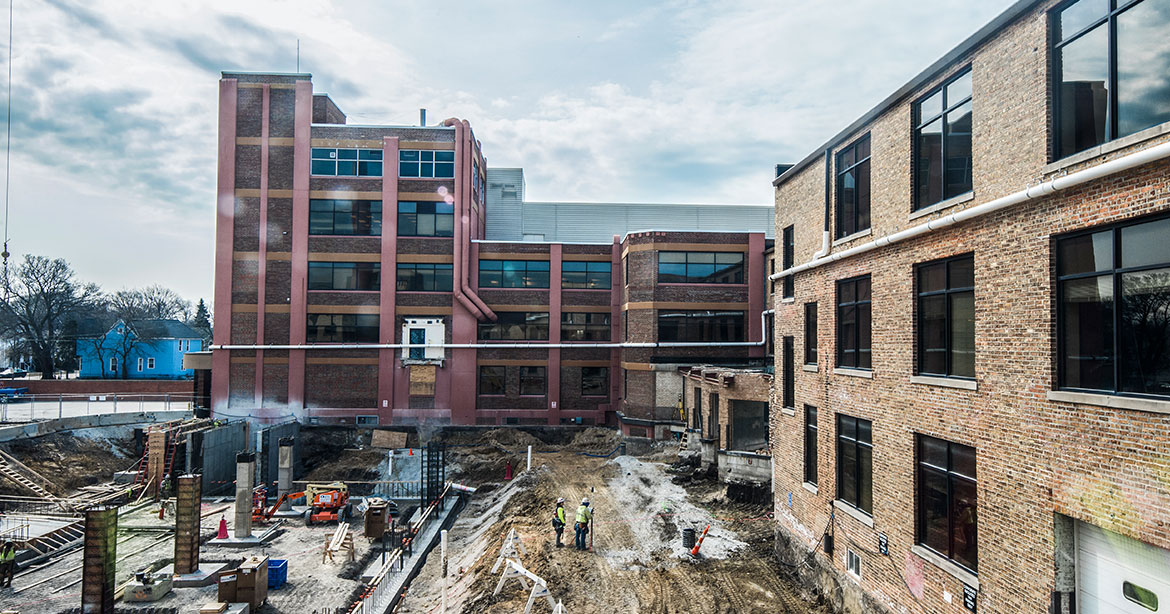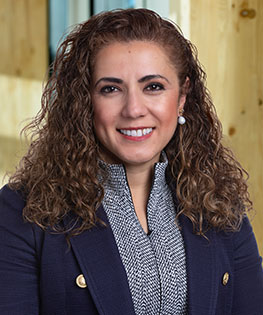
The “build new or renovate” discussion is common as campuses try to attract more students and provide an optimal learning environment. Everyone from campus administration to alumni, students, and parents has a say in what a campus needs to succeed. However, factors like budget constraints, building conditions, and land availability all weigh heavily in determining whether new construction or renovations deliver the best Return on Investment (ROI).
We sat down with higher education market experts Avin Kallenbach, Joe Pritzkow, and Blair McNeil to discuss what they’re seeing in the market and how campuses navigate these difficult decisions.
Based on what you see in the market, what are the main factors currently driving campus construction and renovation projects?
Blair: It usually comes down to two things: either the customer needs to build a new structure to expand housing and programmatic spaces like classrooms, lab, and research space—or they need to freshen up old or antiquated spaces with an updated look and amenities. Regardless of the project type, every decision is centered on enhancing the student’s experience while on campus.
Avin: We’re seeing an increased need for residence halls and student centers as campuses try to add amenities that attract and keep students on campus. A lot of these existing facilities are old or outdated, so they’re looking to renovate or build something new.
Joe: Maintaining/growing enrollment, improving national rankings, and retaining faculty/staff are usually the primary drivers of capital investments. COVID greatly impacted how students learn with many hybrid options continuing to be offered. This necessitates technology infrastructure, which will continue to be a focal point as virtual reality and AI infiltrates the classroom. Student life outside the classroom is also a key focus on campuses. Flexibility in student housing, physical and mental health, and shared amenities continue to be a driver for students and their families.
Budget and building conditions are both major factors in any build vs. renovate decision. What are potential cost challenges and how do they affect whether campuses repurpose facilities or build new?
Blair: In general, the cost to renovate will always be more cost-effective than building new square footage for the same project type, such as renovating an education building to house more classrooms. You already have the footings, foundation, and enclosure there, and sometimes you can repurpose the interior components.
However, owners are often surprised to find the cost delta between new construction versus renovation isn’t always that significant. There are sometimes major financial investments in renovating that you don’t have with new construction like bringing dated mechanical and electrical systems up to code and retrofitting them into an existing building. Accessibility upgrades are another consideration in renovations because it can be costly to bring buildings up to code.
Joe: Something else to consider is the space type being considered. Lab research buildings require extensive mechanical and electrical infrastructure, which drives renovation costs up. Student housing trends show single units with private bathrooms have significantly increased in demand post-COVID, as well as amenities such as laundry, cooking, dishwashers, fitness, parking, pools & spas. This can make it challenging to renovate existing space and create the experience students are looking for.
What about historic buildings on campuses? These must be expensive to renovate, so how do campuses navigate that decision?
Blair: Historic preservation is a critical consideration for owners deciding what to do with a building. Older buildings can have intricate details you don’t see in newer construction. They want to preserve that architectural integrity, even when the cost to renovate is higher than building something new. A lot of stakeholders have a voice in this, too. Students, staff, faculty, alumni, and of course localized historical societies can all have governance over these decisions.
Joe: Oftentimes buildings are also on the National Historic Registry. Campuses can’t (and don’t want to) tear them down, but there are limits to what can be done both internally and to the exterior. In these cases, institutions try to preserve, renovate and repurpose them to suit the current needs. Those improvements often involve extensive interior renovation, including new plumbing and mechanical/electrical system upgrades. It’s expensive, but they need to meet current code requirements.
The limiting factor here is usually whether the building can be repurposed for the intended program use. In older buildings, you can be restricted by interior structural walls, column placements, and ceiling heights. Those factors all determine your layout and how you can use the space. If it just won’t work, then they have no other option but to build new.
Avin: I’ll also add that sometimes older buildings are too far gone to renovate them. The cost would be significantly higher than building something new, so the only option is a mass demolition and building a new structure on that land.
I agree, there are a lot of factors that come into play with these decisions. The University of Minnesota’s Fraser Hall is a 100-year-old building, and while they are interested in preserving the structure because of its architectural significance, there are challenges in making existing spaces work for their current programmatic needs. The university’s solution is a 90,0000-square-foot addition to the building and renovation of the existing interior. Most of the exterior (aside from the addition) will remain untouched, but with all the interior renovations, they’ll essentially have a brand-new facility.
What are the common barriers to building new? If new construction isn’t possible, how can universities ensure they’re meeting programmatic needs through renovations?
Blair: Space is the biggest barrier in new construction, especially with universities in urban settings, where the campus is landlocked. Even some of the rural campuses don’t have spaces available for expansion, which means accommodating a new structure might mean losing a parking lot or green space. Then, institutions have to decide whether the new building is worthy of taking up that spot because eventually, they will run out of space.
In these cases, colleges and universities might decide to renovate a building or build an addition to meet programmatic needs. Or if there’s an undesirable building on campus, they might decide to tear the existing building down and build something new in the same location.
Avin: As far as renovations go, weighing ROI and meeting programmatic needs involves many considerations. Classrooms need to have the right technology and be bigger, brighter, and more accommodating. Institutions want residence halls and student centers that will not only attract students but make them stay on campus longer.
Joe: It’s important to consider life-cycle analysis when making the decision to build new or renovate. Bringing new real estate online requires additional operations and maintenance costs for the entire life of the facility. It’s important to analyze space utilization before making this decision. It’s also important to master plan to ensure campus needs are being looked at holistically. If the need today is to grow or create new space for a specific department, what are the other programmatic needs in the next 5-10 years, and do some of the facilities those programs currently reside in provide a better opportunity to solve for today’s needs?
As you can see, there are no simple answers in the “build or renovate” conversation. Every situation is different, and a multitude of unique considerations weigh on each decision. That’s why it’s important to engage a team early to help plan your project and analyze programmatic options, project and life-cycle costs, and ROIs.

Avin Kallenbach is a project executive focused on education construction. She has worked on several high-profile projects at Mortenson and leads project managers through successful preconstruction and construction planning to ensure the best project outcome for customers.

Blair McNeil is a market director focusing on education construction. He is responsible for business development, customer relationships, and construction management for the Minneapolis office and has worked on several notable projects for the University of Minnesota.

Joe Pritzkow is a market executive focused on education construction. He knows how to navigate university processes with ease and has a proven track record for delivering complex projects while meeting schedule and budget milestones.
News + Insights
[Insight] Reduce Impacts of Campus Construction Projects with Thorough Disruption Avoidance Planning
[Insight] A University’s Role in Minimizing Disruption on Active Campus Construction Projects
[Insight] Tips for Successful Higher Education Construction Planning
see all news + insightsYour Partner in Higher Education Construction
Bring your visions to life with a team invested in making your campus construction project successful. With a proven track record of excellence in higher education construction, there’s no limit to what we can achieve together.